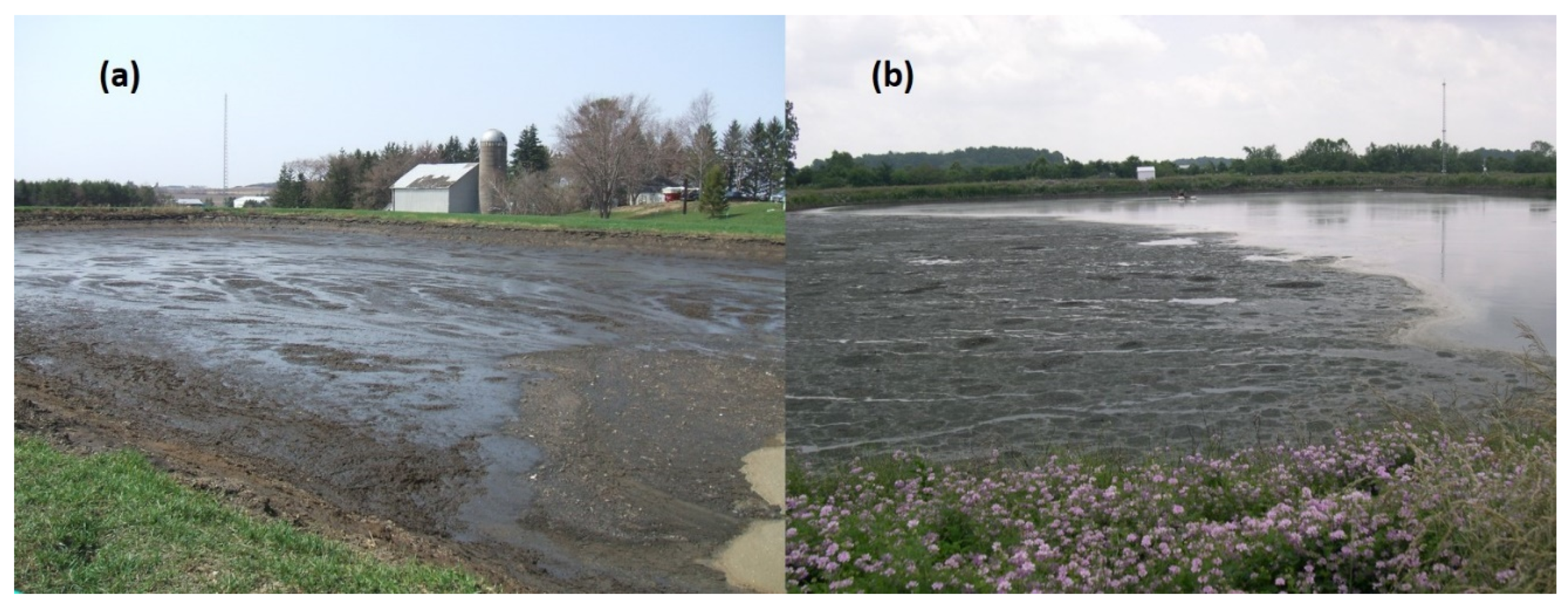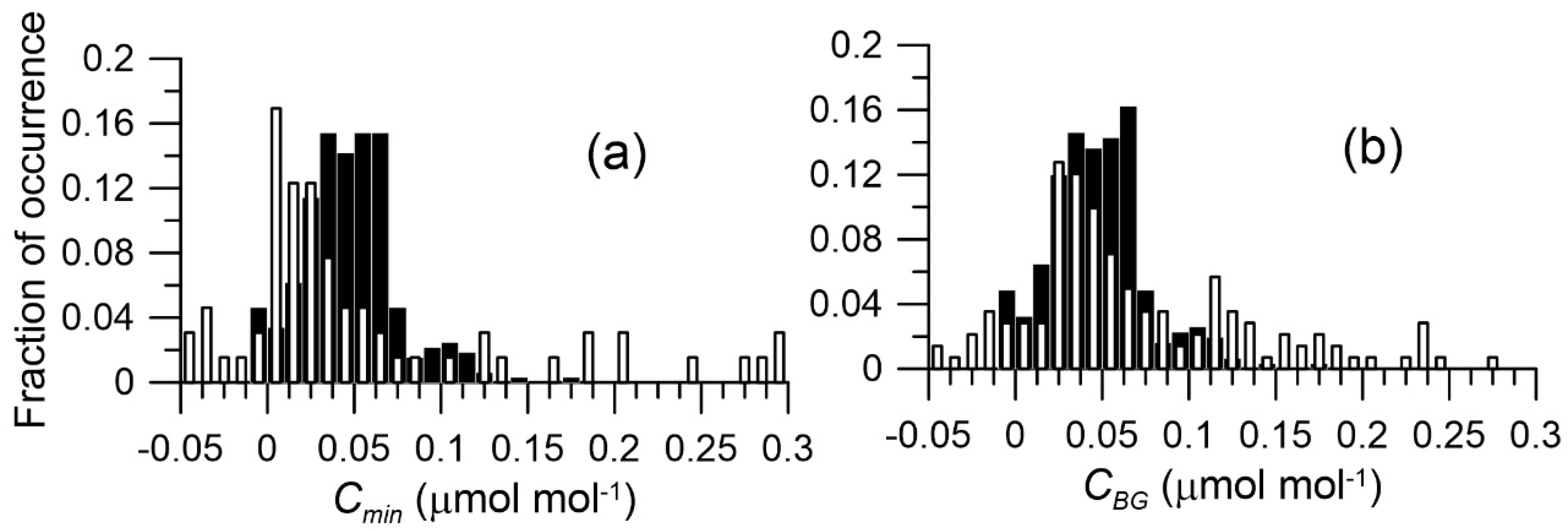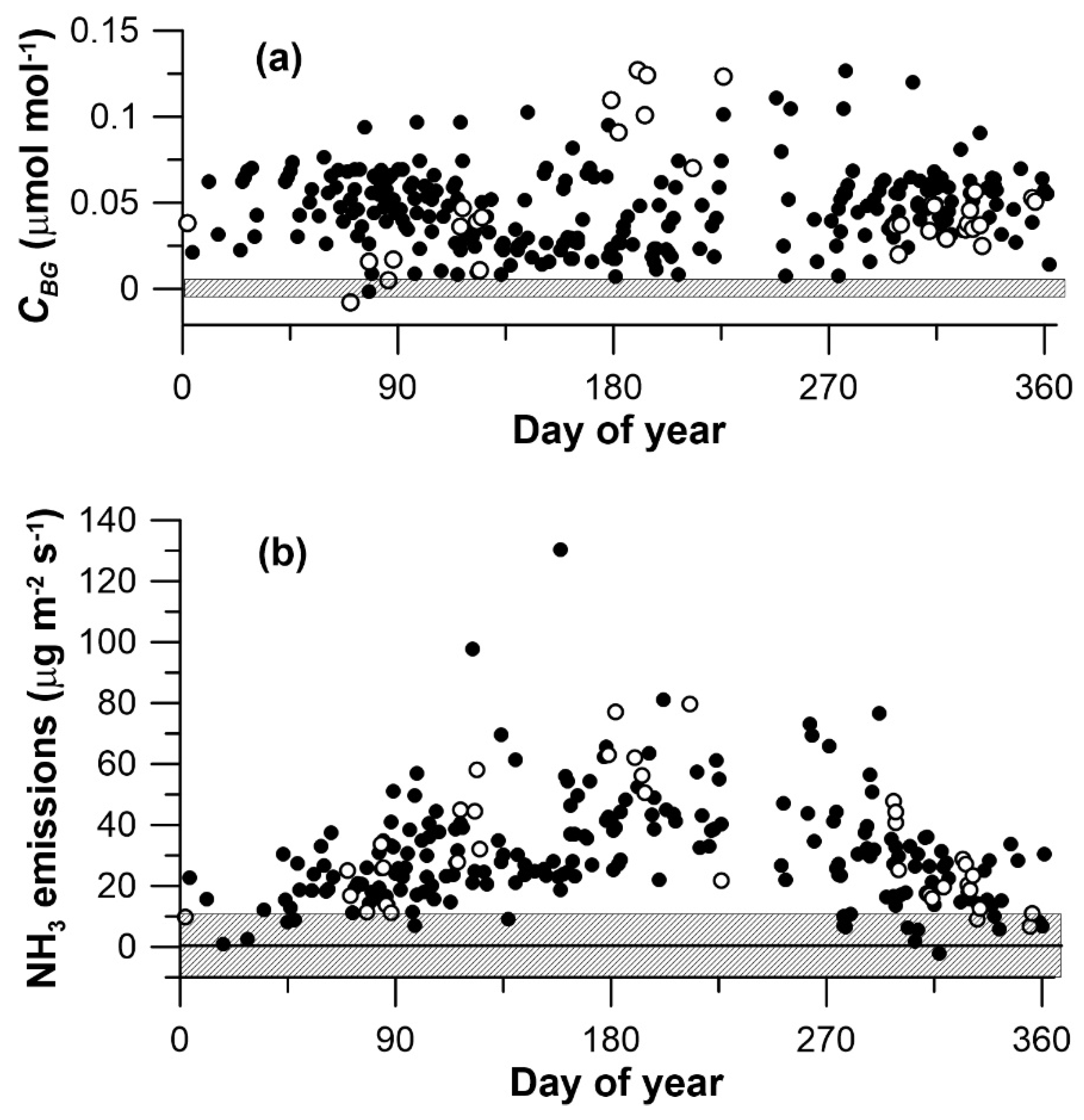Ammonia Emissions from Differing Manure Storage Facilities at Two Midwestern Free-Stall Dairies
Abstract
1. Introduction
2. Experiments
3. Results and Discussion
3.1. Daily Emissions
3.1.1. Temperature Influence
3.1.2. Wind Influence
3.1.3. Influence of Operational Activities
3.2. Seasonal and Annual Emissions
4. Conclusions
Supplementary Materials
Author Contributions
Funding
Acknowledgments
Conflicts of Interest
References
- Inventory of U.S. Greenhouse Gas Emissions and Sinks: 1990–2012; EPA 430-R-14-003; United States Environmental Protection Agency: Washington, DC, USA, 2014. Available online: https://www.epa.gov/ghgemissions/us-greenhouse-gas-inventory-report-archive (accessed on 10 October 2018).
- National Emission Inventory: Ammonia Emissions from Animal Agricultural Operations; Revised Draft Report; United States Environmental Protection Agency: Washington, DC, USA, 2005. Available online: https://www3.epa.gov/ttnchie1/ap42/ch09/related/nh3inventorydraft_jan2004.pdf (accessed on 23 July 2020).
- Battye, W.; Aneja, V.P.; Roelle, P.A. Evaluation and improvement of ammonia emissions inventories. Atmos. Environ. 2005, 37, 3873–3883. [Google Scholar] [CrossRef]
- Rotz, C.A.; Montes, F.; Hafner, S.D.; Heber, A.J.; Grant, R.H. Ammonia Emission Model for Whole Farm Evaluation of Dairy Production Systems. J. Environ. Qual. 2013. [Google Scholar] [CrossRef] [PubMed]
- Baldé, H.; VanderZaag, A.C.; Burtt, S.D.; Wagner-Riddle, C.; Evans, L.; Gordon, R.; Desjardins, R.L.; MacDonald, J.D. Ammonia emissions from liquid manure storages are affected by anaerobic digestion and solid-liquid separation. Agric. Forest Meteorol. 2018, 258, 80–88. [Google Scholar]
- Bjorneberg, D.L.; Leytem, A.B.; Westermann, D.T.; Griffiths, P.R.; Shao, L.; Pollard, M.J. Measurement of atmospheric ammonia, methane, and nitrous oxide at a concentrated dairy production facility in southern Idaho using open-path FTIR spectroscopy. Trans. ASABE 2009, 52, 1749–1756. [Google Scholar] [CrossRef]
- Leytem, A.B.; Dungan, R.S.; Bjorneberg, D.L.; Koehn, A.C. Emissions of ammonia, methane, carbon dioxide, and nitrous oxide from dairy cattle housing and manure management systems. J. Environ. Qual. 2010. [Google Scholar] [CrossRef] [PubMed]
- Todd, R.W.; Cole, N.A.; Hagevoort, G.R.; Casey, K.D.; Avermann, B.W. Ammonia losses and nitrogen partitioning at a southern High Plains open-lot dairy. Atmos. Environ. 2015, 110, 75–83. [Google Scholar] [CrossRef]
- Grant, R.H.; Boehm, M.T. Manure NH3 and H2S emissions from a western dairy storage basin. J. Environ. Qual. 2015, 44, 127–136. [Google Scholar] [CrossRef]
- Flesch, T.K.; Harper, L.A.; Powell, J.M.; Wilson, J.D. Inverse-dispersion calculation of ammonia emissions from Wisconsin dairy farms. Trans. ASABE 2009, 52, 253–265. [Google Scholar] [CrossRef]
- Improving Air Quality: Eleven Years After Agreement, EPA Has Not Developed Reliable Emission Estimation Methods to Determine Whether Animal Feeding Operations Comply With Clean Air Act and Other Statutes, United States Environmental Protection Agency Office of Inspector General, Report No. 17-P-0396. Available online: https://www.epa.gov/sites/production/files/2017-09/documents/_epaoig_20170919-17-p-0396.pdf (accessed on 21 September 2020).
- Grant, R.H.; Boehm, M.T. National Air Emissions Monitoring Study: Data from the Midwestern US Milk Production Facility WI5A; Final Report to the Agricultural Air Research Council; Purdue University: West Lafayette, Indiana, 2010; 119p. Available online: https://archive.epa.gov/airquality/afo2012/web/html/wi5a5b.html (accessed on 1 February 2014).
- Grant, R.H.; Boehm, M.T.; Bogan, B. Methane and carbon dioxide emissions from manure storage facilities at two free-stall dairies. Agric. Forest Meteorol. 2015, 213, 102–113. [Google Scholar] [CrossRef]
- Grant, R.H.; Boehm, M.T. National Air Emissions Monitoring Study: Data from the Eastern US Milk Production Facility IN5A; Final Report to the Agricultural Air Research Council; Purdue University: West Lafayette, Indiana, 2010; 198p. Available online: https://archive.epa.gov/airquality/afo2012/web/html/in5a.html (accessed on 1 February 2014 ).
- Flesch, T.K.; Wilson, J.D.; Harper, L.A.; Crenna, B.P. Estimating farm emissions of ammonia with an inverse dispersion technique. Atmos. Environ. 2005, 39, 4863–4874. [Google Scholar] [CrossRef]
- Laubach, J.; Kelliher, F.A. Measuring methane emission rates of a dairy cow herd (II): results from a backward-Lagrangian stochastic model. Agric. Forest Meteorol. 2005, 129, 137–150. [Google Scholar] [CrossRef]
- Flesch, T.K.; Wilson, J.D.; Harper, L.A.; Crenna, B.P.; Sharpe, R.P. Deducing ground-to-air emissions from observed trace gas concentrations: a field trial. J. Appl. Meteorol. 2004, 43, 487–502. [Google Scholar] [CrossRef]
- Grant, R.H.; Boehm, M.T.; Lawrence, A.J. Comparison of backward-Lagrangian Stochastic and Vertical Radial Plume Mapping methods for estimating animal waste lagoon emissions. Agric. Forest Meteorol. 2013, 180, 236–248. [Google Scholar] [CrossRef]
- Hashmonay, R.A.; Varma, R.M.; Modrak, M.T.; Kagman, R.H.; Segall, R.R.; Sullivan, P.D. Radial Plume Mapping: A US EPA Test Method for Area and Fugitive source emission monitoring using optical remote sensing. In Advanced Environmental Monitoring; Kim, Y.J., Platt, U., Eds.; Springer: Dordrecht, NL, USA, 2008; pp. 21–36. [Google Scholar]
- Hashmonay, R.A.; Natschke, D.F.; Wagoner, K.; Harris, D.B.; Thompson, E.L. Field evaluation of a method for estimating gaseous fluxes from area sources using open-path Fourier transform infrared. Environ. Sci. Technol. 2001, 35, 2309–2313. [Google Scholar] [CrossRef] [PubMed]
- Thoma, E.D.; Green, R.B.; Hater, G.R.; Goldsmith, C.G.; Swan, N.D.; Chase, M.J.; Hashmonay, R.A. Development of EPA OTM 10 for landfill applications. J. Environ. Eng. 2010, 136, 769–776. [Google Scholar] [CrossRef]
- Ro, K.S.; Johnson, M.H.; Varma, R.M.; Hashmonay, R.A.; Hunt, P.G. Measurement of greenhouse gas emissions from agricultural sites using open-path optical remote sensing method. J. Environ. Sci. Health Part A 2009, 44, 1011–1018. [Google Scholar] [CrossRef] [PubMed]
- Ro, K.S.; Johnson, M.H.; Hunt, P.G.; Flesch, T.K. Comparison of Vertical Radial Plume Mapping (VRPM) and backward Lagrangian Stochastic (bLS) Techniques in Measuring Trace Gas Emission from Multiple Distributed Sources. Atmos 2011, 2, 553–566. [Google Scholar] [CrossRef]
- Denmead, O.T. Approaches to measuring fluxes of methane and nitrous oxide between landscapes and the atmosphere. Plant Soil 2008, 309, 5–24. [Google Scholar] [CrossRef]
- Denmead, O.T.; Freney, J.R. Transfer coefficients for water-air exchange of ammonia, carbon dioxide, and methane. Ecol. Bull. 1992, 42, 31–41. [Google Scholar]
- Chemistry WebBook SRD69. Henry’s Law data, Ammonia, National Institute of Standards and Technology, United States Department of Commerce. Available online: https://webbook.nist.gov/cgi/cbook.cgi?ID=C7664417&Units=SI&Mask=10#Solubility (accessed on 1 February 2011).
- Grant, R.H.; Boehm, M.T. Ammonia emissions from anaerobic treatment lagoons at sow and finishing farms in Oklahoma. Agric. Forest Meteorol. 2013, 180, 203–210. [Google Scholar] [CrossRef]
- Herdt, H.H. Nutritional requirements of dairy cattle. Available online: https://www.merckvetmanual.com/management-and-nutrition/nutrition-dairy-cattle/nutritional-requirements-of-dairy-cattle (accessed on 11 August 2017).
- Rumburg, B.; Mount, G.H.; Yonge, D.; Lamb, B.; Westberg, H.; Neger, M.; Filipy, J.; Kinkaid, R.; Johnson, K. Measurements and modeling of atmospheric flux of ammonia from an anaerobic dairy waste lagoon. Atmos. Environ. 2008, 42, 3380–3393. [Google Scholar] [CrossRef]
- Chastain, J.P.; Camberato, J.J. Dairy manure production and nutrient content. In Confined Animal Manure Managers Certification Program Manual B Dairy; Version 1; Clemson University Extension: Clemson, SC, USA, 2004; pp. 3a1–3a16. [Google Scholar]
- Ro, K.S.; Hunt, P.G. A new unified equation for wind-driven surficial oxygen transfer into stationary water bodies. Trans. Amer. Soc. Agric. Biol. Eng. 2006, 49, 1615–1622. [Google Scholar]
- Kupper, T.; Häni, C.; Neftel, A.; Kincaid, C.; Bühler, M.; Amon, B.; VanderZaag, A. Ammonia and greenhouse gas emissions from slurry storage-A review. Agric. Ecosys. Environ. 2020, 300, 106963. [Google Scholar] [CrossRef]
- Misselbrook, T.H.; Powell, J.M. Influence of bedding material on ammonia emissions from cattle excreta. J. Dairy Sci. 2005, 88, 4304–4312. [Google Scholar] [CrossRef]
- Embertson, N.M.; Davis, J.G. Efficacy of best management practices for ammonia reduction on feedlots and dairies. Proc. West. Sec. Amer. Soc. Anim. Sci. 2009, 60, 96–99. [Google Scholar]
- McGinn, S.M.; Coates, T.; Flesch, T.K.; Crenna, B. Ammonia emission from dairy cow manure stored in a lagoon over summer. Can. J. Soil Sci. 2008, 88, 611–615. [Google Scholar] [CrossRef]
- Hamilton, D.W.; Fathepure, B.; Fuhlage, C.D.; Clarkson, W.; Lalman, J. Treatment lagoons for animal agriculture. In Animal Agriculture and the Environment: National Center for Manure and Animal Waste Management White Papers; Rice, J.M., Caldwell, D.F., Humenik, F.J., Eds.; ASABE: St Joseph, MI, USA, 2006; pp. 547–574. [Google Scholar]
- Muck, R.E.; Stenhuis, T.S. Nitrogen losses from manure storages. Agric. Wastes 1982, 4, 41–54. [Google Scholar] [CrossRef]
- Castillo, A.R.; Kebreab, E.; Beever, D.E.; France, J. A review of efficiency of nitrogen utilization in lactating dairy cows and its relationship with environmental pollution. J. Anim. Feed Sci. 2000, 9, 1–32. [Google Scholar] [CrossRef]
- Béline, F.; Martinez, J.; Marol, C.; Guiraud, G. Nitrogen transformations during anaerobically stored 15N-labelled pig slurry. Bioresour. Technol. 1998, 64, 83–88. [Google Scholar] [CrossRef]
- Liu, Z.; Powers, W.; Oldick, B.; Davidson, J.; Meyer, D. Gas emissions from dairy cows fed typical diets in the Midwest, South, and West regions of the United States. J. Environ. Qual. 2012, 41, 1228–1237. [Google Scholar] [CrossRef]
- Swink, S.N.; Ketterings, Q.M.; Chase, L.E.; Czymmek, K.J.; Van Amburgh, M.E. Nitrogen balances for New York State: Implications for manure and fertilizer management. J. Soil Water Cons. 2011, 66, 1–17. [Google Scholar] [CrossRef]
- Ferguson, J.D.; Dou, Z.; Ramberg, C.F. An assessment of ammonia emissions from dairy facilities in Pennsylvania. Sci. World J. 2001, 1, 348–355. [Google Scholar] [CrossRef][Green Version]
- Hubbard, R.K.; Lowrance, R.R.; Wright, R.J. Management of dairy cattle manure. In Agricultural Uses of Municipal, Animal, Industrial Byproducts; Conservation Research Report; Wright, R.R., Kemper, W.D., Millner, P.D., Power, J.F., Korcak, R.F., Eds.; United States Department of Agriculture, Agricultural Research Service: Washington, DC, USA, 1998; Volume 44, pp. 91–102. [Google Scholar]
- Powell, J.M.; McCrory, D.F.; Jackson-Smith, D.B.; Saam, H. Manure collection and distribution on Wisconsin dairy farms. J. Environ. Qual. 2005, 34, 2036–2044. [Google Scholar] [CrossRef] [PubMed]





| Indiana | Wisconsin | |||||||
|---|---|---|---|---|---|---|---|---|
| Air Temperature (°C) | Wind Speed (ms−1) | Air Temperature (°C) | Wind Speed (ms−1) | |||||
| Maximum | Minimum | Mean | Mean | Maximum | Minimum | Mean | Mean | |
| Spring | 27.9 | −6.1 | 9.7 | 3.1 | 23.9 | −21.8 | 4.0 | 3.2 |
| Summer | 33.0 | 7.8 | 20.8 | 1.7 | 33.4 | 7.4 | 20.6 | 2.1 |
| Fall | 29.9 | −9.0 | 10.2 | 2.3 | 22.5 | −15.1 | 3.2 | 3.0 |
| Winter | 17.3 | −29.2 | −4.6 | 3.3 | 5.8 | −26.8 | −11.4 | 2.8 |
| Annual | 33.0 | −29.2 | 8.9 | 2.6 | 33.4 | −26.8 | 7.9 | 2.7 |
| Indiana | Wisconsin | |||||
|---|---|---|---|---|---|---|
| Measurements | Measurements | |||||
| ½ h Field | Valid ½ h Emissions | Valid Day Emissions | ½ h Field | Valid ½ h Emissions | Valid Day Emissions | |
| Spring | 3712 | 3668 | 77 | 1971 | 783 | 12 |
| Summer | 3690 | 2991 | 59 | 2557 | 837 | 7 |
| Fall | 3217 | 2820 | 58 | 1689 | 936 | 15 |
| Winter | 3906 | 2367 | 52 | 1638 | 445 | 3 |
| Annual | 14,525 | 11,846 | 246 | 7855 | 3001 | 37 |
| Farm | Period | NH3 Emissions | ||||
|---|---|---|---|---|---|---|
| Mean g NH3 s−1 | SD ‡ g NH3 s−1 | Mean µg NH3 m−2s−1 | Mean g NH3 hd †−1d−1 | Mean g NH3 AU *−1 d−1 | ||
| WI | Spring | 0.20 | 0.105 | 28.8 | 31.6 | 24.9 |
| Summer | 0.42 | 0.137 | 58.7 | 64.3 | 50.6 | |
| Fall | 0.17 | 0.075 | 24.6 | 24.3 | 21.0 | |
| Winter | 0.07 | 0.015 | 9.2 | 10.1 | 8.0 | |
| Annual | 0.21 | 30.3 | 40.0 | 32.1 | ||
| Total | 0.22 | 31.2 | 33.1 | 26.8 | ||
| IN | Spring | 0.24 | 0.033 | 28.4 | 8.96 | 6.79 |
| Summer | 0.39 | 0.039 | 38.2 | 14.2 | 9.27 | |
| Fall | 0.26 | 0.086 | 24.3 | 9.52 | 6.52 | |
| Winter | 0.17 | 0.016 | 17.8 | 5.22 | 4.47 | |
| Annual | 0.26 | 27.2 | 10.0 | 7.08 | ||
| Total | 0.27 | 30.4 | 9.47 | 6.76 | ||
Publisher’s Note: MDPI stays neutral with regard to jurisdictional claims in published maps and institutional affiliations. |
© 2020 by the authors. Licensee MDPI, Basel, Switzerland. This article is an open access article distributed under the terms and conditions of the Creative Commons Attribution (CC BY) license (http://creativecommons.org/licenses/by/4.0/).
Share and Cite
Grant, R.H.; Boehm, M.T. Ammonia Emissions from Differing Manure Storage Facilities at Two Midwestern Free-Stall Dairies. Atmosphere 2020, 11, 1108. https://doi.org/10.3390/atmos11101108
Grant RH, Boehm MT. Ammonia Emissions from Differing Manure Storage Facilities at Two Midwestern Free-Stall Dairies. Atmosphere. 2020; 11(10):1108. https://doi.org/10.3390/atmos11101108
Chicago/Turabian StyleGrant, Richard H., and Matthew T. Boehm. 2020. "Ammonia Emissions from Differing Manure Storage Facilities at Two Midwestern Free-Stall Dairies" Atmosphere 11, no. 10: 1108. https://doi.org/10.3390/atmos11101108
APA StyleGrant, R. H., & Boehm, M. T. (2020). Ammonia Emissions from Differing Manure Storage Facilities at Two Midwestern Free-Stall Dairies. Atmosphere, 11(10), 1108. https://doi.org/10.3390/atmos11101108






